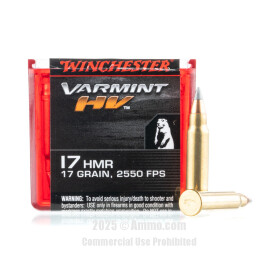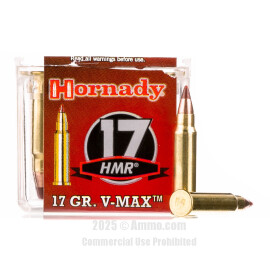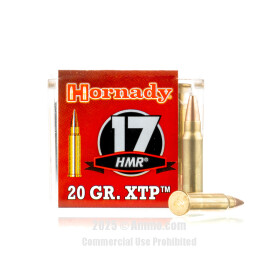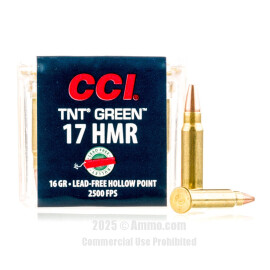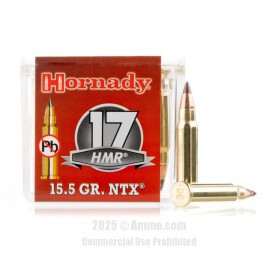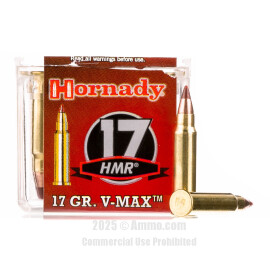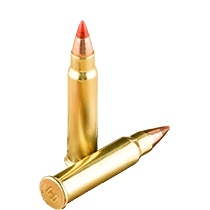
17 HMR Ammo For Sale
Overview of 17 HMR Ammo
The .17 Hornady Magnum Rimfire (17 HMR) was developed as a joint venture between Hornady, Marlin, and Ruger released in 2002. It is an incredibly lightweight rimfire cartridge with a flat trajectory and high velocity, making it a favorite of varmint hunters and long-range rimfire shooters.
The 17 HMR was nothing short of an overnight success as the round accomplished what wildcatters had been doing for many years, replicating the ballistics of the obsolete 5mm Remington Rimfire Magnum (the fastest rimfire cartridge in history). Shooters adored the round so much that ammo sales for the new cartridge quickly outstripped production capacity. Thankfully, within two years of its release, Remington, CCI, and Federal all began offering their own lines of 17 HMR ammo to help keep up with demand. Today, 17 HMR ammo is also available from Winchester as well.
Best 17 HMR Ammo for Specific Use Cases
| Use Case | Details |
|---|---|
| Best 17 HMR Ammo | Best Overall: Hornady 17 grain V-MAX. Runner-Up: CCI 20 grain FMJ. |
How Does The 17 HMR Compare To Other Rimfire Calibers?
| Caliber | Recoil | Pros | Cons |
|---|---|---|---|
| 22 Long Rifle | Same | 17 HMR has flatter trajectory and more accurate | 17 HMR has more expensive ammo |
| 22 Magnum | Same | 17 HMR has flatter trajectory and more accurate | 17 HMR has less stopping power |
Customer Reviews
-
Griz said:
I enjoyed doing business with you and I’ll get back with you and get more ammunition
-
FRANCIS said:
This ammo never let's any shooter down !
-
Drop tine said:
I've shot and killed at 150 yards.this cartridge is by far the best varmint round I have used.
-
UpDownRange said:
I purchased a Savage A17 several years ago. 1st and only weapon of this calibre. Before buying what to me was a novelty rifle I did a lot of reading about the ammo. Savage, in their literature, says to use this ammo to feed this rifle. It has been engineered and tested to run in this gun. So I have exclusively. Never had a problem with weapon or ammo, other than the plastic "drum" magazine. If a manufacturer were to develop a metal mag it would sell out I imagine. I have no idea of other .17s, don't have any and never fired any. This ammo is so fast and flat that at 200y where you'd be expecting some drop it doesn't happen. So either zero at that distance or aim a little high. The reticles in your scope don't compensate for this round. As to pricing, CCI knows they have the market for this rifle, albeit there was a lot of testing to get a round that works consistently, I still think they're charging a bit more than they should/round.
-
Hart said:
I shoot this and numerous other brands of 17 HMR bullets out of a scoped, old age and bad eyes, CZ 452 bolt action rifle and over the past 17 years I have not had any problems with this or any other brand of 17s. The quality of brass and bullets are par for Winchester, I’m satisfied with it and wouldn’t hesitate to buy more should I need it, Have a sufficient supply for now.
-
Buddy B said:
Poor quality , very poor , several misfires per 12 rounds , Winchester ammunition has hit the ditch ! Have always enjoyed using Winchester shells , but won't waste my money anymore , bye bye Felicia !!!
-
city4366 said:
I bought 350 round and in my new 17 Savage I got 2 out of every 10 to fire sorry batch of ammo I ever bought
-
marcblueturtle said:
Bought several boxes. Just now got around to firing some in my Henry Golden Boy 17 HMR. Shot 100 rounds. 15 failed to fire. Good strike marks on rim. Just failed. Bad!! I have never had any other 17 cal brand do this. In fact, since I have had my Henry, I have had no failures until now. I read some other reviews around the internet and some had more failures per 100 than I did. Very disappointed in Winchester. Once I get these boxes used up at firing range, I will buy no more and I sure would not use these loads if I were out coyote hunting. -
-
Cowboy45 said:
At 50 yards, can punch a single hole, in a five shot group.
-
Mayo said:
All ammo performed extremely well. Haven’t had any blow back or misses
-
Sapman said:
Plays hell on a squirrels noggan.
-
its me said:
it just cost so much to shoot small game anymore.
-
Jackal said:
Pretty comparable price to other brands but with the Hornady vmax I have never had a misfire plus it feeds very well in my 93r17 savage bolt action. very consistent groups at 200 yards ( without wind ) Love this stuff and wont shoot anything else ! getting hard to find now, I guess others are finding the same results ! ;-)
